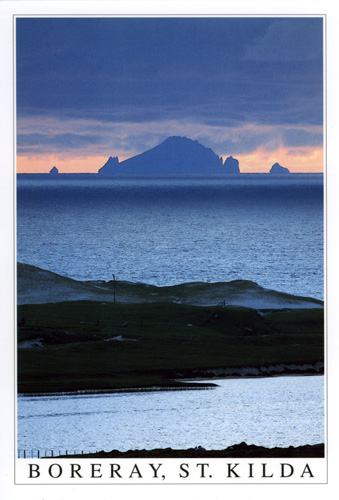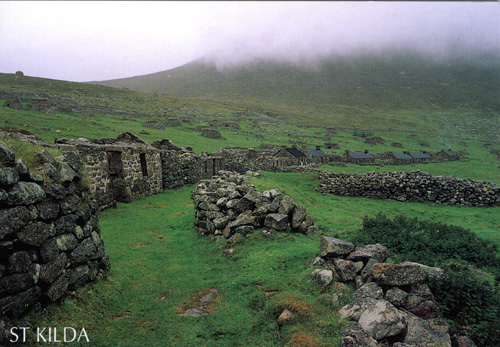St Kilda
The small archipelago of St Kilda consists of five islands (Hirta, Boreray, Soay, Dun and Levenish) situated 40 miles west of the Hebrides.

The sheer cliffs rise 1300 feet from the water and are the highest seacliffs in the UK. The name may not refer to a saint but rather be a corruption of the Norse word skilder, shields, or alternatively of the name of the largest island, Hirta.
The group has been inhabited continually since prehistoric times, with the principal settlement on Hirta, and was visited in 1697 by Martin Martin who recorded the self-sufficient way of life then. The community became known for its tradition of harvesting seabirds for food, oil and feathers, and for the St Kilda Parliament, a daily meeting of the men of the village to discuss the day’s business. Sheep were naturally a crucial element in the economy and rent to the Macleod landlords was paid annually in kind.
A ‘mail boat’ was used to deliver messages to the mainland or other islands – sometimes desperate ones asking for assistance when food was short. The mail boat was a small wooden box attached to an inflated sheep’s bladder, cast into the water to be taken (usually north-east) by the current, in the hope that it would eventually reach the mainland.
From the middle of the nineteenth century, illness, food shortages and contact with the wider world began to impact on the sustainability of the community.
After years of decline and emigration, the remaining 36 inhabitants asked to be evacuated to the mainland in 1930. Details of the island’s last households can be found on the ScotlandsPeople website, A digitisation of the St Kilda school logbook covering the years 1900-1930 can be downloaded via the Tasglann nan Eilean website.
St Kilda is now owned by the National Trust for Scotland (which maintains a detailed website on the islands) and is a dual World Heritage Site, recognised for both its cultural and its natural significance. Further historical information can be found on the website of the National Records of Scotland.
Over recent months, Jura Consultants have been assessing the suitability of three potential sites (Mangurstadh in Uig, Leverburgh in Harris and Cleitrebhal in North Uist) for the establishment of a St Kilda Centre.
The community of Uig was honoured to be selected as the recommended location – specifically the Geodha Sgoilt, a remote corner of Uig on a vertical cliff looking out to the islands. The recommendation was accepted by the St Kilda Steering Group (comprised of Comhairle nan Eilean Siar, Highlands and Islands Enterprise, the National Trust for Scotland, Visit Scotland and Proiseact nan Ealan) and noted by the full Comhairle, and now a process of planning and fundraising will ensue.
The recommendation has been described in the press as “controversial”, but it’s worth mentioning that it is only controversial to those who feel that either Uist or Harris had a prior claim on the centre, principally because St Kilda is in the parish of Harris and belonged to the Dunvegan Macleods, and was once repopulated by Hearachs when its population was reduced, according to tradition, to one cailleach. We don’t dispute these connections, but believe that Uig has attributes that will make Ionad Hiort a tremendous asset to the whole of the Western Isles, and indeed Scotland, and do justice to the World Heritage status that St Kilda has attained for its historical, cultural and natural riches.
The community of Uig believes that a St Kilda Centre in Uig will optimise the visitor experience. Nowhere else in the Outer Hebrides offers the same combination of ‘accessible remoteness’ along with a natural and social environment that has so much in common with St Kilda.
The community felt it was appropriate to publish our shared vision for the Centre.
Mangurstadh lies within an hour’s drive of Stornoway, the Outer Hebrides’ main town and transport hub, but offer a strong sense of isolation. The journey to Uig takes you down the longest cul-de-sac in Scotland, perhaps in Europe. You are conscious of driving away from centres of population to a notably more remote and dramatically beautiful place – past lochs and moorland, through the dramatic Valtos Glen, above the stunning white sands of Traigh Uig and to breathtaking views of sea cliffs and stacks, and of St Kilda and the Flannan Isles on the horizon. Arriving at the St Kilda Centre in Uig will feel like reaching the edge of the world, raw and unspoiled.
The site at Geodha Sgoilt (see photo) is directly above the spectacular sea cliffs and stacks of the Mangurstadh headland. Visitors will get a sense of what it feels like to be on St Kilda, in the landscape and natural environment that are, of all parts of the Outer Hebrides, most like it. From the headland, the spring passage of Pomarine and other skuas can be observed. Fulmars nest hear and soar past on air currents around the cliffs. Gannets, razorbills, guillemots and other sea-birds can all be viewed diving into the sea. the bird populations that characterise St Kilda and which played a pivotal role in its economy. St Kilda without seabirds is unthinkable so it is essential that the St Kilda Centre should be in a setting that evokes their presence. Echoing St Kilda, the sea cliffs in Mangurstadh host plant communities dominated by extreme forms of Atlantic maritime vegetation- roseroot, scot’s lovage, sea campion – and arctic-alpine plants such as purple saxifrage and moss campion.
Although in an area of wild natural beauty, the site bears the derelict remains of concrete plinths and buildings left by the MOD. A new build on this site would cause minimal disturbance to the natural environment and could rectify the damage left by the military. The Mangurstadh to Breinis road runs through the area, offering views of the spectacular coastline, including its extraordinary dramatic rock stacks.
Because of the deep water which lies off the Uig cliffs, the same rich and varied species of sea life which is to be found around St Kilda can be observed here. Whales, porpoises, basking sharks and dolphins are all frequently to be seen relatively close to shore, and the diving is comparable to that off St Kilda. These similarities are significant, as St Kilda’s World Heritage status was granted in part for its marine environment.
Two long-standing operators of trips from Uig to St Kilda – Seatrek and Island Cruising – also take visitors out to sea and to other uninhabited islands, notably the gannet-inhabited Flannans.
The landscape surrounding the centre is therefore as significant as anything that may be contained within it. Visitors to the Centre would be able to see the cliffs and their bird life and other natural features; feel the power of the sea crashing against the land and understand some of the challenges that faced St Kilda. Within the centre, the life of St Kilda will be interpreted through archives, artefacts and film. A large-scale audio visual installation will bring the St Kildan experience home to visitors, and technology can be used to observe birds and marine life, and to make accessible the riches of our pristine natural environment, including the sky at night. The Centre will provide educational and research facilities across the educational spectrum. The building itself should be iconic and sustainable, attracting attention in the world of environmental design and architecture. Extending the purpose of the centre through cultural and educational activities to become a year-round facility is a strong element of our proposal.
We believe it is essential that the Gaelic identity of the St Kildans is reflected and respected in the proposed Centre. The unique remoteness and isolation of St Kilda compounded the adversities that were part of everyday life for all islanders, and Uig knew about life in a remote community, dominated by the sea. As on St Kilda, small-scale cropping and raising stock to graze on smaller islands were supplemented by fishing, and homespun tweed was a central element of the crofting economies, used for rent and barter. The fowling that was such an important part of St Kildan life was practised to a lesser degree in Uig, but cliffs of Uig replicate the conditions and demonstrate the hazards that faced the men who ventured out after puffins and gannets.
The St Kilda Centre in Uig needs to be an outward-looking centre of world-wide significance, offering something completely unique – much more than a seasonal attraction for passing visitors.
It will be of a different magnitude, housed in an iconic building in a spectacular landscape, and with state-of-the-art technology will bring the experience of St Kilda closer.
Our focus is on what Uig can reflect of island life, and the seas and skies around it. Therefore we see an emphasis on education, a cultural programme, year-round facilities to reach large segments of the resident population and partnerships with other WHS institutions – creating a real cultural destination and a world-class facility appropriate to St Kilda, which, as a World Heritage Site, belongs now not to any one location but to the world.
Links
St Kilda Dancers – Aerial dancers filmed on Mangurstadh cliffs as part of Proiseact nan Ealan’s St Kilda Opera project in 2007. More pictures of the dancers (and the cliffs) are here.
St Kilda is a double World Heritage Site managed by the National Trust for Scotland – Their website provides extensive information about the history, natural environment and current uses of the island, and our historical notes and news releases on St Kilda are here.
Seatrek – Seatrek offers sightseeing/wildlife boat trips around the stunning Uig coast, Isle of Lewis (Stornoway) and Outer Hebrides.
Island Cruising – Island cruises take you to remote Islands around the Hebrides or Western Isles of Scotland as they are also known.We specialise in trips to St Kilda and some of the following Islands en route, Scarp, Taransay, Monach Isles and the Flannan Isles.
The Lost Isle – Colin Campbell’s photo set ‘The abandoned island of St. Kilda, Outer Hebrides, Scotland.’
If you would like to leave a comment or get in touch with us…
You can visit our facebook page Uig Historical Society where we will be able to contact you. We have a great facebook family who are always happy to help with anything from dates, photographs and any information regarding Uig.






